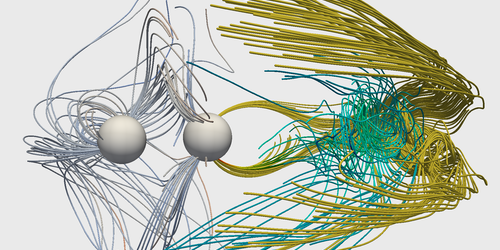Radio Bursts Precede Coalescence of Neutron Stars
In the intense magnetic field above a rapidly spinning neutron star’s poles, electrons accelerate so rapidly that they emit gamma rays. The interaction of these gamma rays with the star’s magnetic field produces an electron–positron plasma. Now researchers predict that a similar series of events occurs just before two neutron stars collide [1], producing a radio-wave signal that could be detectable by the future Square Kilometer Array, which is expected to come online in 2027.
Elias Most of the California Institute of Technology and Alexander Philippov of the University of Maryland, College Park, find that as the stars approach each other, their orbital motion speeds up enough that their magnetic fields produce an electron–positron plasma. In the moments before the merger, the electromagnetic energy of this plasma swiftly burgeons, bursting through the binary’s twisted magnetic field. As the field lines start snapping into new, straighter configurations, they hurl flares that crash into the plasma in the orbital plane. For the Sun, this process results in solar flares. For a coalescing neutron-star binary, Most and Philippov predict that the interaction causes bursts of radio waves that precede the emission of gravitational waves from the merger by 1 second. The bursts, which have a frequency of 10–20 gigahertz, are akin to the fast radio bursts from magnetars.
–Charles Day
Charles Day is a Senior Editor for Physics Magazine.
References
- E. R. Most and A. A. Philippov, “Reconnection-powered fast radio transients from coalescing neutron star binaries,” Phys. Rev. Lett. 130, 245201 (2023).




